Before setting up a whisky production line, we must know What Is Whisky?
Simply put, "whisky" is the common name for all distilled spirits made from grains.
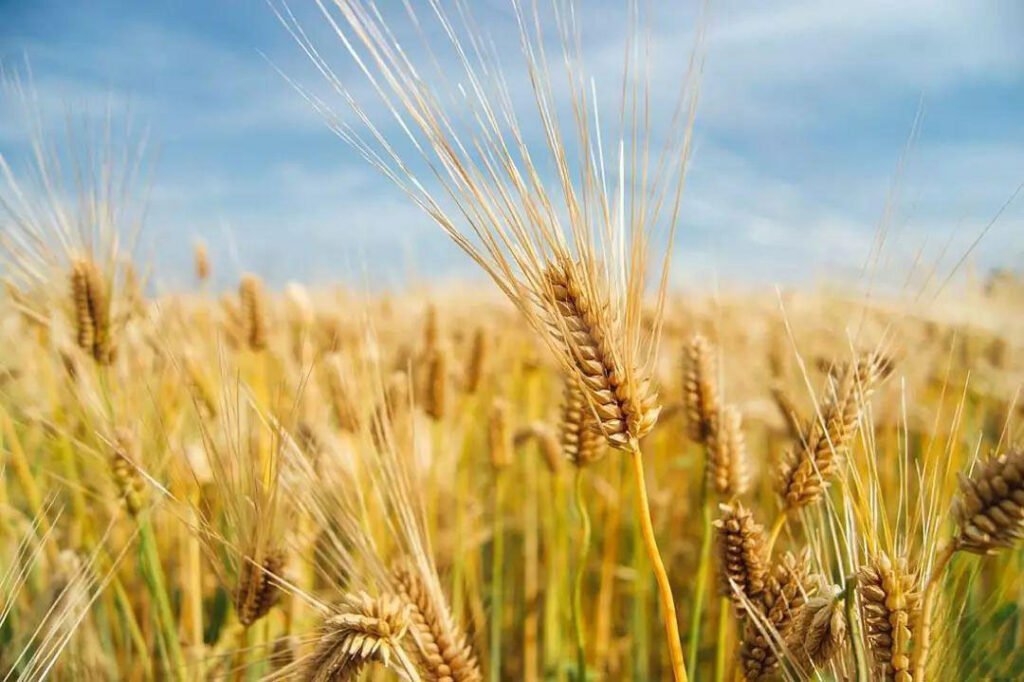
Whisky is the language of the Celts who lived in Ireland and the Scottish Highlands in ancient Times.
The ancient Irish called it VISAGE-BEATHA. And the ancient Scotsman called it VISAGE BAUGH.
It took a thousand years of change to evolve into Whisky.
Whisky is also written differently in different countries.
Ireland and the United States writing Whiskey, while Scotland and Canada write Whisky.
In general, whisky has an alcohol concentration of 50%-60% and has malt aromas.
If it’s Scotch whisky, it has a smoky flavor.
This is because Scotch whisky is dried with peat during brewing.
Since the flavor and aroma of whisky are influenced by oak barrels, brewing processes, and the surrounding environment, whisky tastes vary from distillery to distillery.

What Things Are Need To Make Whisky?
- Raw materials: water, wheat and other grains, peat and yeast.
- Equipment: grain soaking pools(steep), malt floor, drying oven, cooling grounds, miller, mash tun, liquid storage tanks, fermentation tanks, distillation equipment, oak barrels, bottled packaging lines.
Good water is the key to making whisky. Minerals, microorganisms, and the hardness of the water all affect the taste of whisky. As a result, whisky distilleries are generally built-in places with good water sources nearby.
Most whisky is made from barley. The malted barley is the main source of flavors for single malt whisky. But corn, rye, and wheat are also used to make other kinds of whisky, such as bourbon in the United States.
In Scotland, peat is used in the drying steps of malt to increase the smoky taste of Scotch whisky.
There are many kinds of yeast. Their effect on the fermentation process is not the same. So the type and quantity of yeast are regarded as a whisky distillery’s secret. generally speaking, in the fermentation process, the whisky plant will use at least two different varieties of yeast for fermentation. But at most, more than a dozen different varieties of yeast are mixed together for fermentation.
Oak barrels generally use American white oak, European oak, and in recent years Japanese oak has also been received.
What is the process of whisky production line?
The Whisky production line process has 7 steps:
Malting – Mashing – Fermentation – Distillation – Aging/Maturing – Blending – Bottling
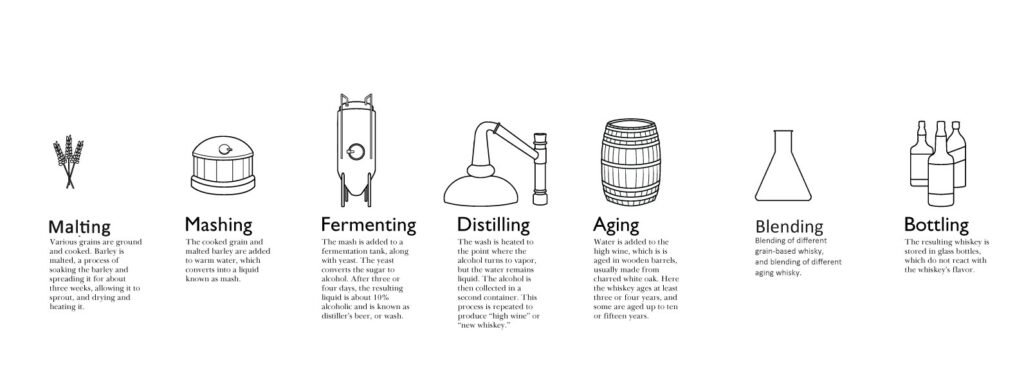
1. Malting

Soak grains such as barley in steep. Change the water 2 or 3 times during soaking. During this period, oxygen helps grains absorb water more quickly. Depending on the size of the grain, the entire soaking process lasts 1-3 days.
When the grain’s water content reaches 45%, spread grains onto the malt floor. Stir grains regularly to avoid the high temperature impacting germination. Depending on the temperature, grains start to germinate in 4-9 days.
During germination, grains release growth hormones. Growth hormone helps grains take root and germinate, releasing enzymes. Alpha and beta amylase are the keys to converting starch into sugar.
When the sprout reaches to three-fourths length of the grain, the germination process can be ended by drying. Drying also eliminates bacteria and mold. After drying, the barley’s water content is 4% to 5%. At this point, it tastes like a wort, and it’s obviously sweet. If it’s dried with peat, it smells smoky now. The amount of peat is calculated in parts per million phenols. Lightly peated malt contains 2 to 10 parts per million phenols, while heavily contains 50-60 parts per million.
Cool the malt and store it for about a month. Then the malting process is complete.
2. Mashing
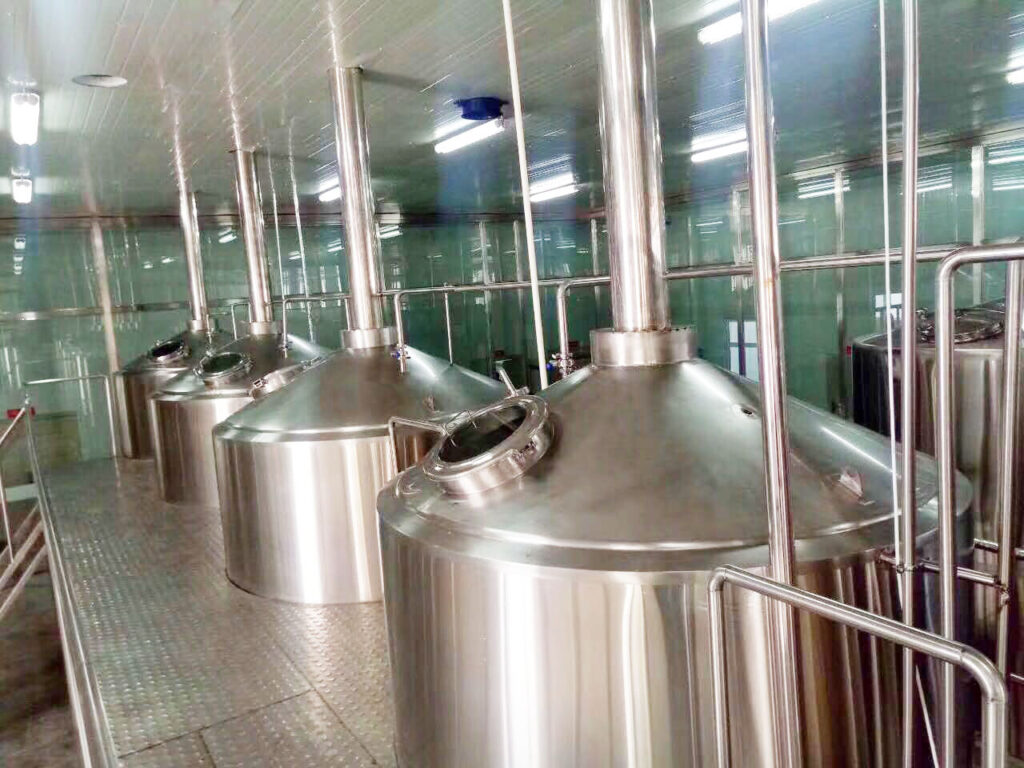
Before mashing, ground malt to grist by miller. This is to make the sugar be extracted better in next step.
Put malt into mash tun and mix it with hot water at a temperature 62-65 degrees Celsius. And stir continuously in the mash tun. During stirring, beta amylases convert starch into various forms of sugar. After about 30 minutes, drain the liquid and collect it for fermentation. Then re-add 70-75 degrees of water to repeat the steps above.
The third time, mix malt with 80 degrees of hot water and stir. The discharge of liquid is not directly used for next fermentation steps. Instead, collect it and cool it to 64 degrees for the next step in the mashing process.
Temperature and time control are important for the whole process. Excessive temperatures or long periods of time can affect the quality of wort.
3. Fermentation

Fill cold water or coolant into the jacket of the fermentation tank. Cool the wort to 16-20 degrees. Add yeast to the cooled malt wort for fermentation. Yeast converts sugar into alcohol and carbon dioxide. After the fermentation process, we get a liquid with an alcohol content of 8%-11%. We call it “Wash” or “Beer”. The fermentation process typically takes up to 4 days.
4. Distillation
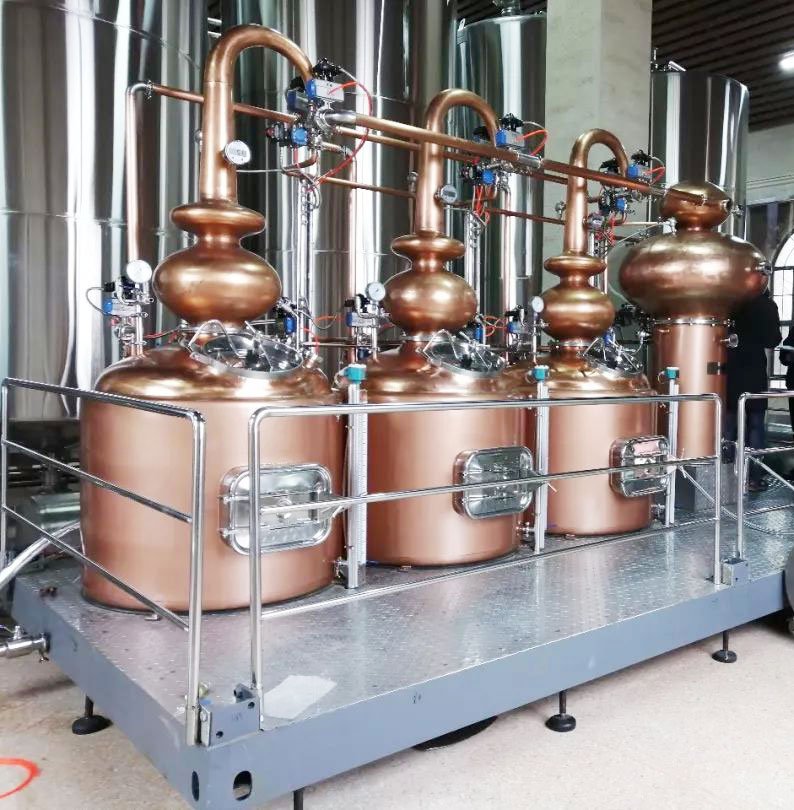
Distillation is the process of concentrating a liquid. Heat Wash or beer in the first copper still. Alcoholic vapors rise in the neck of the still. Because the alcohol evaporates at a lower temperature than water. The alcohol vapors are cooled and condensed again in the condenser. Now the liquid, which is known as low wine, has alcohol content of 20%-25%.
Repeat this step in the second copper still. Get a liquid called spirit still, with an alcohol content of 65-70%. Now the spirit still has most of the taste and aroma of whisky. The whole process takes about 8 hours.
The copper still contains the kettle, gooseneck/line arm, condenser. it is generally made from copper. Because copper is an excellent heat conductor, and easy to form, what’s more, can cut unwanted sulfur. The size and shape of the still can also have an effect on the taste of whisky.
The distilled liquid consists of residues from the previous burn process and volatile toxic methanol, heart, and faints. Whisky distilleries take only the middle “Heart” to become the new spirit. In the screening of the “heart” volume, there are no fixed unified proportion standards. It is by the distillery’s requirements. The general proportion of each distillery to take “heart” is 60% to 70%. There are distilleries that take their highest purity part to make high-quality whisky. The world-renowned Macallan single malt whisky uses only 17% of the “heart” as a new spirit for whisky.
5. Aging
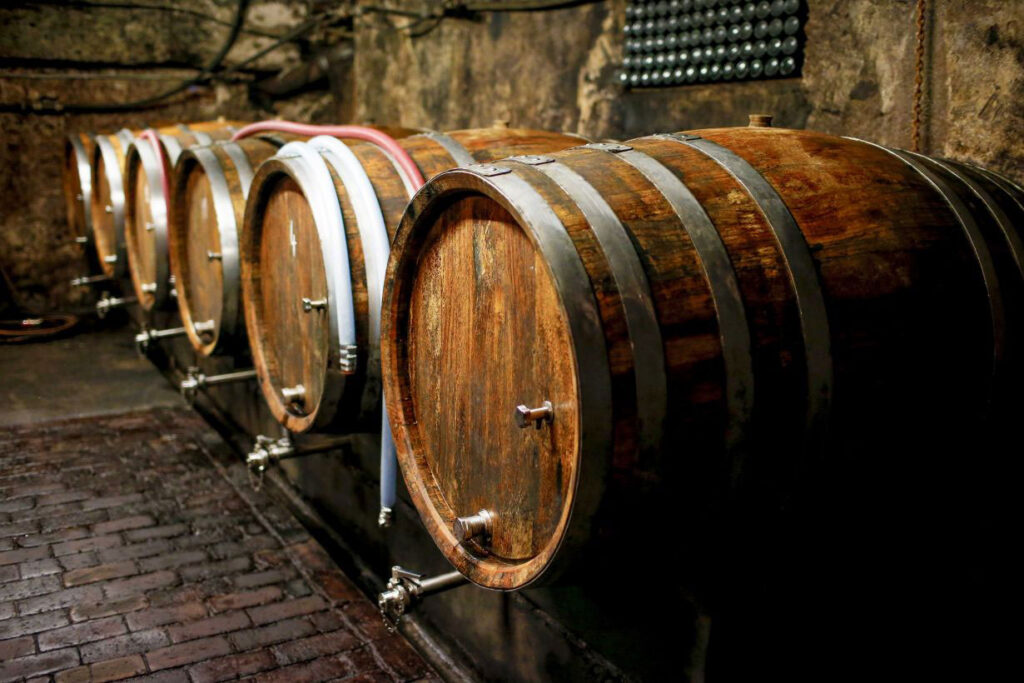
A new spirit after distillation must have an aging process. Age the new spirit in oak barrels. The new spirit absorbs the natural aromas of and produces beautiful amber. And gradually reducing the strong spicy of its high alcohol concentration. After aging, the taste can reach 60%-80% of the final whisky taste.
The law in Scotland requires that Scotch whisky must be stored in a barrel for at least three years. Because wood breaths 1.5 and 2% of the liquid gold vapored annually that is called the angel’s share. With such strict measures, Scotland whisky has a high-quality image in the world.
And the oak barrels also have a great influence on the taste of whisky. To increase the flavor of whisky, some distilleries use used barrels. For example, sherry barrels, American Bourbon barrels, rum, and Barolo barrels. But if a barrel has been used several times, whisky can’t absorb its taste.
6. Blending
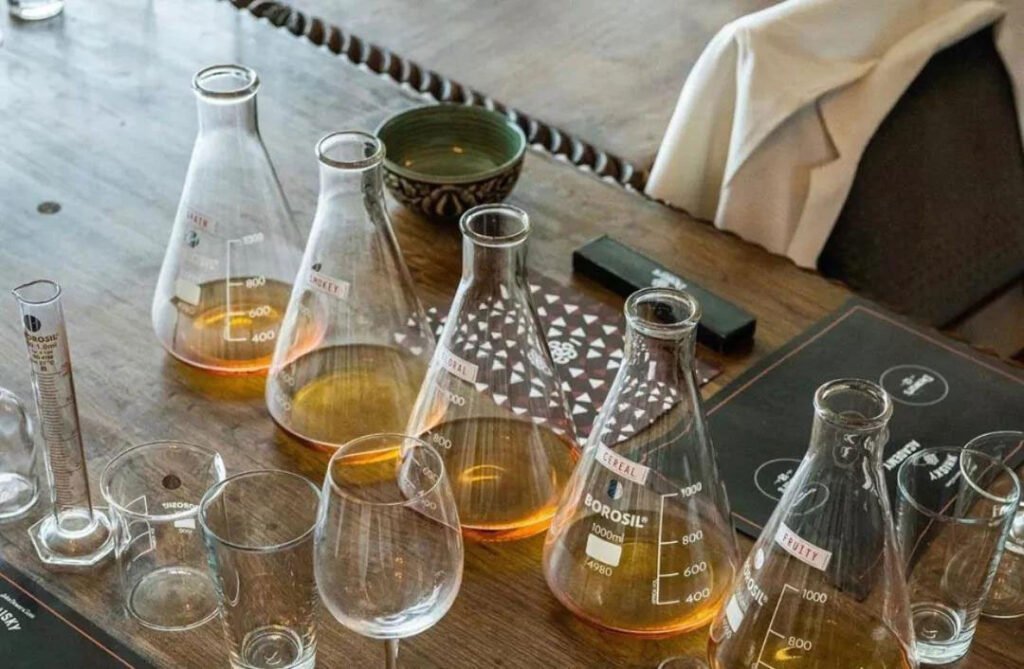
Blending contains two meanings. Blending of different grain-based whisky, and blending of different aging whisky.
Due to the wide variety of grains, the different grain-based whisky flavors are different. Each distillery bartender mixes their own distinctive taste with a certain proportion. The mixing process and content of each brand are considered absolutely confidential. And mixed whisky quality is entirely determined by wine tasting experts and consumers.
7. Bottling
After the blending process is complete, the last left is bottling. Before bottling, filter the mixed whisky again to remove its impurities. The automatic bottling machine fills a fixed capacity of whisky into each bottle. After putting on manufacturers’ trademarks, pack bottled whisky in the box for sale.
The filling machine is key equipment in this process. Whisky has a high alcohol content of 40%-60%. So we equip the machine with explosion-proof motors to keep the entire operation safe. Fully automated and visual operations also greatly reduce the difficulty of production.
In the actual sales process, labels are the key to attracting customers. Distilleries choose the type and quantity of labels according to the target market. Generally, in whisky, self-adhesive labels are used more. Single label on front, double label with front and back, or three labels with front, back and neck labels. These are common labeling type for whisky.
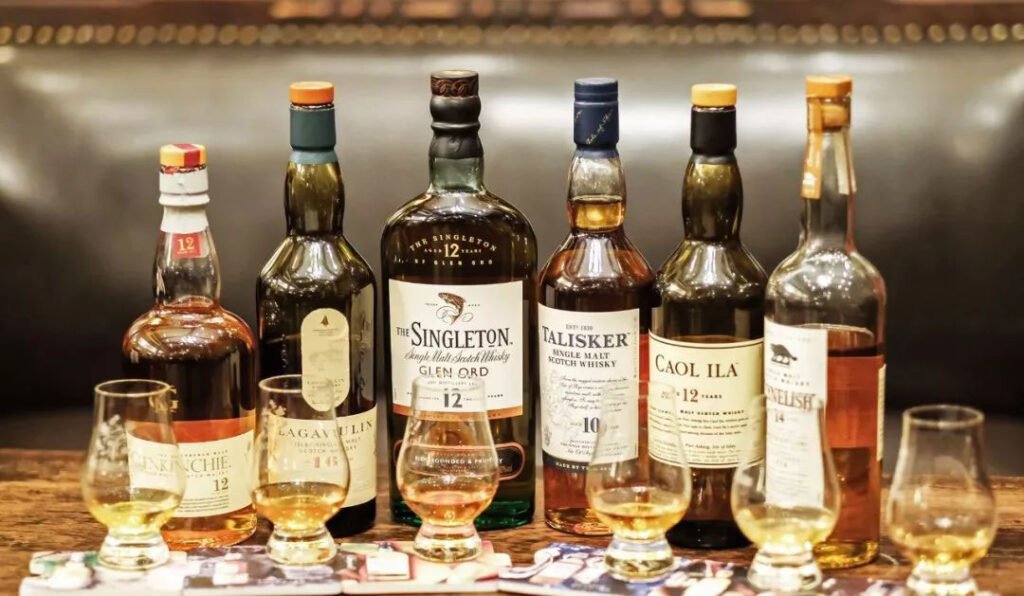
Whisky is not a drink, it is a philosophy of life. If whisky is a philosophy of life who’s the man who makes whisky? When you have water, and winemakers, you probably know it. Linho will always be with you to supply any help.
If you are interested in Alcohol Drink Business, please check


